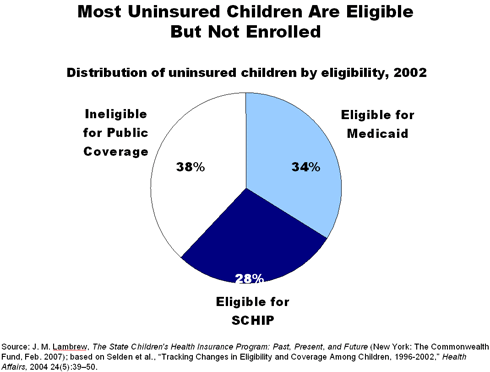At the end of the 2007 fiscal year, congressional authorization for the State Children's Health Insurance Program (SCHIP)—hailed as a safety net for children in families that have too much income to qualify for Medicaid but too little to afford private insurance—is set to expire. The reauthorization process will take place at a time when the uninsured rate for children is once again on the rise.
As reported recently in the New York Times, 13 of the nation's governors—seven Republicans and six Democrats—have sent Congress and the Bush administration an urgent letter asking for swift action, saying they are on the verge of running out of federal money to pay for the program.
In her new report prepared for The Commonwealth Fund Commission on a High Performance Health System, George Washington University's Jeanne Lambrew, Ph.D., examines the array of policy options legislators are likely to consider for SCHIP during reauthorization—historically a time for Congress to review, refine, and revamp programs. Lambrew says members must decide three key issues.

Whom Should SCHIP Cover?
Currently, SCHIP is targeted at families with income between 100 percent and 200 percent of the poverty level, although 15 states cover children in families with incomes over 200 percent of poverty. States that had in place high income thresholds for children's coverage prior to SCHIP were permitted to cover children up to 250 percent of poverty; other states have obtained waivers to enroll children at higher income levels.
Even without expanding eligibility, millions more children could be enrolled by redoubling efforts to reach those who are eligible for the program but not signed up, says Lambrew. Experience shows there are a number of effective practices for enrolling uninsured children: simpler applications and re-enrollment procedures, seamless eligibility rules, and aggressive marketing. Congress could decide to make use of such "best practices" mandatory.

Another proven way to raise participation in children's health insurance programs is to make their parents eligible as well. Lambrew cites one study that found children's participation of children in SCHIP and Medicaid was 14 percentage points higher when parents themselves were eligible.
Still another option to weigh is opening up SCHIP to children who are eligible based on income but otherwise barred from participating, like immigrant children. Or all uninsured children, regardless of income, could be made eligible, with higher-income parents assessed a premium. "On the surface, this may be the most achievable coverage expansion," Lambrew notes, adding that "the idea of covering children enjoys particularly broad popular support."
What Kind of Coverage Should Enrollees Receive?
Although Lambrew says the states and the federal government have achieved a "sustainable balance" in designing SCHIP's benefit package, as the reauthorization deadline approaches policymakers have floated ideas for changing benefit standards or improving coverage. For example, some state SCHIP directors desire greater flexibility to implement partial benefit packages that "wrap around" other insurance coverage and fill in benefit gaps.
In terms of improving the quality of care provided to SCHIP children, "more remains to be done," Lambrew says. Some policymakers see low provider payment rates, relative to private insurance, as a roadblock to better quality; others say it is more a matter of improving quality standards and aggressively enforcing them. Lambrew notes that although improving care standards "may be viewed by some states and employers as constraining, there is wide support for doing so."
How Should SCHIP Be Financed?
A number of options exist for extending, modifying, or overhauling SCHIP's financing structure. The president has proposed restricting the use of SCHIP funding to low-income, uninsured children. Some members of Congress, meanwhile, have supported making SCHIP available to children in families earning up to 300 percent of the poverty level. Lawmakers could also decide to refine the formula for allocating and redistributing funds or, alternatively, raise the overall level of federal funding to keep pace with medical inflation, projected enrollment growth, or national health expenditure growth.
The challenges of expanding and improving children's health insurance are "serious but surmountable," Lambrew believes. "Regardless of outcome," she says, "the debate over SCHIP reauthorization will offer an opportunity to reassess...the balance of federal and state governance, the relative roles of public and private insurers, the definition of coverage, and the public's willingness to pay for results."